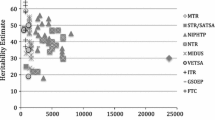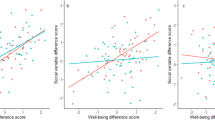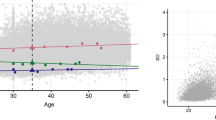Abstract
We analyzed genetic and environmental determinants of self-rated health and its change from adolescence to early adulthood. Questionnaires were mailed to Finnish twins born 1975–1979 at ages 16, 17, \(18\frac{1}{2}\) and, on average, 25 years of age (N = 2465 complete twin pairs). The data were analyzed using quantitative genetic methods for twin data by the Mx statistical package. Heritability of self-rated health was greatest at age 16 (63%, 95% confidence intervals (CI) 56–67%, men and women together) and declined steadily to age 25 (33%, 95% CI 25–41%). The residual variation was due to unshared environments. Health ratings at different ages were modestly correlated (r = 0.33–0.61). These correlations were mainly due to genetic factors, but unshared environment also contributed to them. An important challenge for further research is to identify environmental influences contributing to self-rated health independently of, or in interaction with, genetic factors.


Similar content being viewed by others
References
Boomsma D, Busjahn A, Peltonen L (2002) Classical twin studies and beyond. Nat Rev Genet 3:872–882
Christensen K, Holm NV, McGue M, Corder L, Vaupel JW (1999) A Dannish population-based twin study on general health in the elderly. J Aging Health 11:49–64
Elstad JI (2005) Childhood adversities and health variations among middle-aged men: a retrospective lifecourse study. Eur J Public Health 15:51–58
Harris JR, Pedersen NL, McClearn GE, Plomin R, Nesselroade JR (1992) Age differences in genetic and environmental influences for health from the Swedish Adoption/Twin Study of Aging. J Gerontol 47:P213–P220
Idler EL, Benyamini Y (1997) Self-rated health and mortality: a review of twenty-seven community studies. J Health Soc Behav 38:21–37
Idler EL, Kasl SV (1995) Self-ratings of health: do they also predict change in functional ability? J Gerontol 50B:S344–S353
Kaprio J, Pulkkinen L, Rose RJ (2002) Genetic and environmental factors in health-related behaviours: studies on Finnish twins and twin families. Twin Res 5:366–371
Leinonen R, Kaprio J, Jylhä M, Tolvanen A, Koskenvuo M, Heikkinen E, Rantanen T (2005) Genetic influences underlying self-rated health in older female twins. J Am Geriatr Soc 53:1002–1007
Loos R, Derom C, Vlietinck R, Derom R (1998) The East Flanders prospective twin survey (Belgium): a population-based register. Twin Res 4:167–175
Mäkinen T, Laaksonen M, Lahelma E, Rahkonen O (2006) Associations of childhood circumstances with physical and mental functioning in adulthood. Soc Sci Med 62:1831–1839
Manderbacka K (1998) Examining what self-rated health question is understood to mean by respondents. Scand J Soc Med 26:145–153
Manderbacka K, Lahelma E, Martikainen P (1998). Examining the continuity of self-rated health. Int J Epidemiol 27:208–213
Martikainen P, Aromaa A, Heliövaara M, Klaukka T, Knekt P, Maatela J, Lahelma E (1999) Reliability of perceived health by sex and age. Soc Sci Med 48:1117–1122
Miilunpalo S, Vuori I, Oja P, Pasanen M, Urponen H (1997) Self-rated health status as a health measure: the predictive value of self-reported health status on the use of physician services and on mortality in the working-age population. J Clin Epidemiol 50:517–528
Neale MC (2003) Mx: statistical modeling. 2 edn. Box 710 MCV, Richmond, VA 23298: Department of Psychiatry
Neale MC, Cardon LR (1992) Methodology for genetic studies of twins and families. Kluwer Academic Publisher, Dordrecht
Plomin R, Spinath FM (2004) Intelligence: genetics, genes, and genomics. J Pers Soc Psychol 86:112–129
Power C, Hyppönen E, Davey Smith G (2005) Socioeconomic position in childhood and early adult life and risk of mortality: a prospective study of the mothers of the 1958 British birth cohort. Am J Public Health 95:1396–1402
Rahkonen O, Arber S, Lahelma E (1995) Health inequalities in early adulthood: a comparison of young men and women in Britain and Finland. Soc Sci Med 41:163–171
Romeis JC, Scherrer JF, Xian H, Eisen SA, Bucholz K, Heath AC, Goldberg J, Lyons MJ, Henderson WG, True WR (2000) Heritability of self-reported health. Health Serv Res 35:995–1010
Røysamb E, Tambs K, Reichborn-Kjennerud T, Neale MC, Harris JR (2003) Happiness and health: environmental and genetic contributions to the relationship between subjective well-being, perceived health, and somatic illness. J Pers Soc Psychol 85:1136–1146
Sarna S, Kaprio J, Sistonen P, Koskenvuo M (1978) Diagnosis of twin zygosity by mailed questionnaire. Hum Hered 28:241–254
Svedberg P, Lichtenstein P, Pedersen NL (2001) Age and sex differences in genetic and environmental factors for self-rated health: a twin study. J Gerontol 56B:S171–S178
Sweeting H (1995) Reversals of fortune? Sex differences in health in childhood and adolescence. Soc Sci Med 40:77–90
Sweeting H, West P (2003) Sex differences in health at ages 11, 13 and 15. Soc Sci Med 56:31–39
Acknowledgments
The FinnTwin16 study has been supported by the National Institute on Alcohol Abuse and Alcoholism (grant AA08315, AA12502, and AA00145), the Academy of Finland (grants 44069, 100499 and 205585) and the European Union Fifth Framework Program GenomEUtwin project (QLG2-CT-2002-01254). KS is supported by the Academy of Finland (grant 108297). DP is supported by NWO/MaGW Vernieuwingsimpuls 016-065-318.
Author information
Authors and Affiliations
Corresponding author
Additional information
Edited by Peter McGuffin and John Hewitt
Rights and permissions
About this article
Cite this article
Silventoinen, K., Posthuma, D., Lahelma, E. et al. Genetic and Environmental Factors Affecting Self-Rated Health from Age 16–25: A Longitudinal Study of Finnish Twins. Behav Genet 37, 326–333 (2007). https://doi.org/10.1007/s10519-006-9096-1
Received:
Accepted:
Published:
Issue Date:
DOI: https://doi.org/10.1007/s10519-006-9096-1




